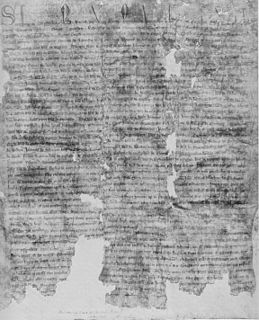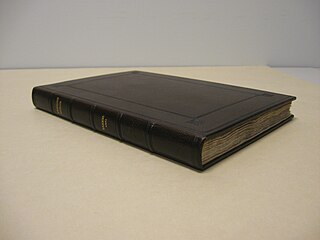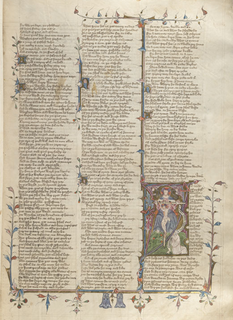 W
WThe Accord of Winchester is the 11th-century document that establishes the primacy of the Archbishop of Canterbury over the Archbishop of York.
 W
WThe Auchinleck Manuscript, NLS Adv. MS 19.2.1, currently forms part of the collection of the National Library of Scotland. It is an illuminated manuscript copied on parchment in the 14th century in London. The manuscript provides a glimpse of a time of political tension and social change in England. The English were continuing to reclaim their language and national identity, and to distance themselves from the Norman conquerors who had taken over the country after the Battle of Hastings 300 years before.
 W
WThe Barons' Letter of 1301 was written by seven English earls and 96 English barons to Pope Boniface VIII as a repudiation of his claim of feudal overlordship of Scotland, and as a defence of the rights of King Edward I of England as overlord of Scotland. It was, however, never sent. The letter survives in two copies, known as A and B, both held in the National Archives at Kew under the reference E 26. Historically they were held amongst the documents in the Exchequer, Treasury of the Receipt department.
 W
WThe Bruges Garter Book is a 15th-century illuminated manuscript containing portraits of the founder knights of the Order of the Garter. It was made to the order of William Bruges, Garter King of Arms, and constitutes the first armorial covering members of the Order. It has been held since 1883 by the British Library in London under catalogue reference Stowe MS 594, indicating its former existence within the Library of the Dukes of Buckingham at Stowe House.
 W
WThe Dering Manuscript is the earliest extant manuscript text of any play by William Shakespeare. The manuscript combines Part 1 and Part 2 of Henry IV into a single-play redaction. Scholarly consensus indicates that the manuscript was revised in the early 17th century by Sir Edward Dering, a man known for his interest in literature and theater. Dering prepared his redaction for an amateur performance starring friends and family at Surrenden Manor in Pluckley, Kent, where the manuscript was discovered in 1844. This is the earliest known instance of an amateur production of Shakespeare in England. Sourced from the 1613 fifth quarto of Part 1 and the 1600 first quarto of Part 2, the Dering Manuscript contains many textual differences from published quarto and folio editions of the plays. Dering cut nearly 3000 lines of Shakespearian text and added some 50 lines of his own invention along with numerous minor interventions. The Dering Manuscript is currently a part of the collection at the Folger Shakespeare Library in Washington, DC.
 W
WDrexel 3976, also known as The Rare Theatrical, is a 17th-century music manuscript compilation of works by the composer Matthew Locke, considered by some to be "the father of all Restoration dramatic music." The manuscript is a significant source of Locke's instrumental dramatic music with many works not known through any other source, although the contexts of the individual works and the names of the plays which they are from has not been documented.
 W
WDrexel 4041 is a 17th-century British music manuscript commonplace book. As described by musicologist John P. Cutts, Drexel 4041 "is a treasure-house of early seventeenth-century song and dramatic lyric worthy of the attention of any student of seventeenth-century literature and drama." It is also a major source for the work of English composer William Lawes. Belonging to the New York Public Library, it forms part of the Drexel Collection, housed in the Music Division of the New York Public Library for the Performing Arts. Following traditional library practice, its name is derived from its call number.
 W
WDrexel 4175, also known by an inscription on its cover, "Ann Twice, Her Book" or by the inscription on its first leaf, "Songs unto the violl and lute," is a music manuscript commonplace book. It is a noted source of songs from English Renaissance theatre, considered to be "indispensable to the rounding-out of our picture of seventeenth-century English song." Belonging to the New York Public Library, it forms part of the Music Division's Drexel Collection, located at the New York Public Library for the Performing Arts. Following traditional library practice, its name is derived from its call number.
 W
WDrexel 4180–4185 is a set of six manuscript partbooks copied in Gloucester, England, containing primarily vocal music dating from approximately 1615-1625. Considered one of the most important sources for seventeenth century English secular song, the repertoire included represents a mixture of sacred and secular music, attesting to the partbooks' use for entertainment and pleasure, rather than for liturgical use.
 W
WDrexel 4257, also known by an inscription on its first page, "John Gamble, his booke, amen 1659" is a music manuscript commonplace book. It is the largest collection of English songs from the first half to the middle of the 17th century, and is an important source for studying vocal music in its transition from Renaissance music to Baroque music in England. Many songs also provide commentary on contemporary political events leading up to the Restoration.
 W
WDrexel 4302, also known as the Sambrook Book based on an inscription from a former owner, Francis Sambrook, is a music manuscript containing vocal and keyboard music from Italian and British composers, documenting the transition from Renaissance to Baroque music. Though literature on the manuscript has assumed the copyist was Francis Tregian the Younger, recent analysis has demolished that hypothesis.
 W
WDrexel 5611 is a 17th-century music manuscript compilation of works written for virginal. Dating from either the end of the Commonwealth period or the early Restoration period, it is an important source for English keyboard music. It also includes a handful of works by French composers, reflecting the growing interest among English musicians in contemporary French keyboard music.
 W
WDrexel 5856 is a music manuscript containing works composed by George Frideric Handel. It is a significant primary source of the composer's work, having been copied by one of Handel's frequent copyists, John Christopher Smith, possibly as a presentation copy.
 W
WThe Drexel Collection is a collection of over 6,000 volumes of books about music and musical scores owned by the Music Division of The New York Public Library. Donated by Joseph W. Drexel in 1888 to the Lenox Library, the collection, located today at the New York Public Library for the Performing Arts, is rich with materials on music theory and music history as well as other musical subjects. It contains many rare books and includes a number of significant 17th-century English music manuscripts.
 W
WThe Ellesmere Chaucer, or Ellesmere Manuscript of the Canterbury Tales, is an early 15th-century illuminated manuscript of Geoffrey Chaucer's Canterbury Tales, owned by the Huntington Library, in San Marino, California. It is considered one of the most significant copies of the Tales.
 W
WThe Exeter Book, Exeter Cathedral Library MS 3501, also known as the Codex Exoniensis, is a tenth-century book or codex which is an anthology of Anglo-Saxon poetry. It is one of the four major Anglo-Saxon literature codices, along with the Vercelli Book, Nowell Codex and the Cædmon manuscript or MS Junius 11. The book was donated to the library of Exeter Cathedral by Leofric, the first bishop of Exeter, in 1072. It is believed originally to have contained 131 leaves, of which the first 8 have been replaced with other leaves; the original first 8 pages are lost. The Exeter Book is the largest known collection of Old English literature still in existence.
 W
WHemming's Cartulary is a manuscript cartulary, or collection of charters and other land records, collected by a monk named Hemming around the time of the Norman Conquest of England. The manuscript comprises two separate cartularies that were made at different times and later bound together; it is in the British Library as MS Cotton Tiberius A xiii. The first was composed at the end of the 10th or beginning of the 11th century. The second section was compiled by Hemming and was written around the end of the 11th or the beginning of the 12th century. The first section, traditionally titled the Liber Wigorniensis, is a collection of Anglo-Saxon charters and other land records, most of which are organized geographically. The second section, Hemming's Cartulary proper, combines charters and other land records with a narrative of deprivation of property owned by the church of Worcester.
 W
WJohn of Wallingford was a Benedictine monk at the Abbey of St Albans, who served as the abbey's infirmarer at some time between c.1246-7 and his death in 1258. He is now mostly known through a manuscript containing a miscellaneous collection of material, mostly written up by Wallingford from various works by his contemporary at the abbey Matthew Paris, which survives as British Library Cotton MS Julius D VII. This manuscript includes the so-called Chronica Joannis Wallingford or Chronicle of John of Wallingford.
 W
WThe Junius manuscript is one of the four major codices of Old English literature. Written in the 10th century, it contains poetry dealing with Biblical subjects in Old English, the vernacular language of Anglo-Saxon England. Modern editors have determined that the manuscript is made of four poems, to which they have given the titles Genesis, Exodus, Daniel, and Christ and Satan. The identity of their author is unknown. For a long time, scholars believed them to be the work of Cædmon, accordingly calling the book the Cædmon manuscript. This theory has been discarded due to the significant differences between the poems.
 W
WThe Macro Manuscript is a collection of three 15th-century English morality plays, known as the "Macro plays" or "Macro moralities": Mankind, The Castle of Perseverance, and Wisdom. So named for its 18th-century owner Reverend Cox Macro (1683–1767), the manuscript contains the earliest complete examples of English morality plays. A stage plan attached to The Castle of Perseverance is also the earliest known staging diagram in England. The manuscript is the only source for The Castle of Perseverance and Mankind and the only complete source for Wisdom. The Macro Manuscript is a part of the collection at the Folger Shakespeare Library in Washington, D.C.. For centuries, scholars have studied the Macro Manuscript for insights into medieval drama. As Clifford Davidson writes in Visualizing the Moral Life, "in spite of the fact that the plays in the manuscript are neither written by a single scribe nor even attributed to a single date, they collectively provide our most important source for understanding the fifteenth century English morality play."
 W
WThe Miroir or Glasse of the Synneful Soul is a manuscript book that was given to Catherine Parr by her stepdaughter, the future Elizabeth I of England in 1544, when Elizabeth was eleven years old. Elizabeth translated the poem from the French work Miroir de l'âme pécheresse by Marguerite de Navarre, into English prose and wrote the manuscript with her own hand, dedicating it with the words, "From Assherige, the last daye of the yeare of our Lord God 1544 ... To our most noble and vertuous Quene Katherin, Elizabeth her humble daughter wisheth perpetuall felicitie and everlasting joye," Elizabeth probably also embroidered the bookbinding. This book is now owned by the Bodleian Library.
 W
WThe Nowell Codex is the second of two manuscripts comprising the bound volume Cotton MS Vitellius A XV, one of the four major Anglo-Saxon poetic manuscripts. It is most famous as the manuscript containing the unique copy of the epic poem Beowulf. In addition to this, it contains first a fragment of The Life of Saint Christopher, then the more complete texts Wonders of the East and Letters of Alexander to Aristotle, and, after Beowulf, a poetic translation of Judith. Due to the fame of Beowulf, the Nowell codex is also sometimes known simply as the Beowulf manuscript. The manuscript is located within the British Library with the rest of the Cotton collection.
 W
WThe Peterborough Chronicle, one of the Anglo-Saxon Chronicles, contains unique information about the history of England after the Norman Conquest. According to philologist J.A.W. Bennett, it is the only prose history in English between the Conquest and the later 14th century.
 W
WThe Textus Roffensis, fully titled the Textus de Ecclesia Roffensi per Ernulphum episcopum and sometimes also known as the Annals of Rochester, is a mediaeval manuscript that consists of two separate works written between 1122 and 1124. It is catalogued as "Rochester Cathedral Library, MS A.3.5" and is currently on display in a new exhibition at Rochester Cathedral, Rochester, Kent. It is thought that the main text of both manuscripts was written by a single scribe, although the English glosses to the two Latin entries were made by a second hand. The annotations might indicate that the manuscript was consulted in some post-Conquest trials. However, the glosses are very sparse and just clarify a few uncertain terms. For example, the entry on f. 67r merely explains that the triplex iudiciu(m) is called in English, ofraceth ordel.
 W
WThe Trevelyon Miscellany of 1608, compiled by Thomas Trevelyon in London, England in 1608, is an illustrated manuscript miscellany containing handwritten notes and drawings on historical, religious, social and practical themes, adapted from a variety of sources, including the Bible and ancient and contemporary English writers. According to Dr. Heather Wolfe, Curator of Manuscripts and Archivist at the Folger Shakespeare Library, "the primary purposes of the Trevelyon miscellany ... are didactic and mnemonic. The extracts and examples from secular, allegorical, and Protestant texts are an enduring monument for improving one's moral conduct in this life and preparing for the next."
 W
WThe Vercelli Book is one of the oldest of the four Old English Poetic Codices. It is an anthology of Old English prose and verse that dates back to the late 10th century. The manuscript is housed in the Capitulary Library of Vercelli, in northern Italy.
 W
WThe Vernon Manuscript is a medieval English manuscript, written in the dialect spoken in the English West Midlands around 1400, that is now in the Bodleian Library, to whom it was presented around 1677 by Colonel Edward Vernon. It has been described as "the biggest and most important surviving late medieval English manuscript" and "one of the Bodleian Library’s greatest treasures".